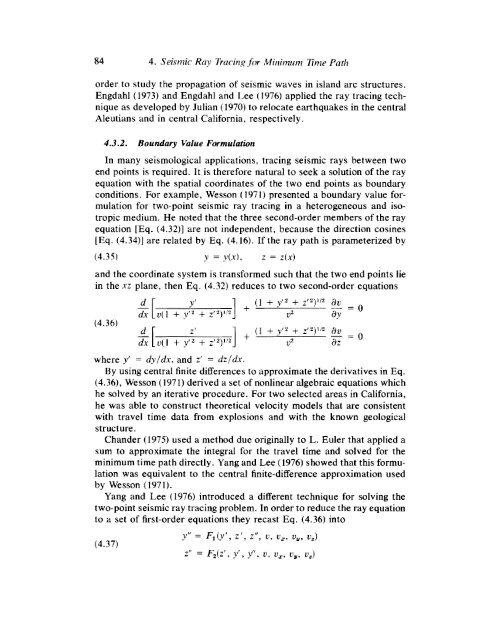principles and applications of microearthquake networks
principles and applications of microearthquake networks
principles and applications of microearthquake networks
You also want an ePaper? Increase the reach of your titles
YUMPU automatically turns print PDFs into web optimized ePapers that Google loves.
(1<br />
84 4. Seismic Ray Tracing for Minimum 7ime Path<br />
order to study the propagation <strong>of</strong> seismic waves in isl<strong>and</strong> arc structures.<br />
Engdahl (1973) <strong>and</strong> Engdahl <strong>and</strong> Lee (1976) applied the ray tracing technique<br />
as developed by Julian (1970) to relocate earthquakes in the central<br />
Aleutians <strong>and</strong> in central California, respectively.<br />
4.3.2. Boundary Value Formulation<br />
In many seismological <strong>applications</strong>, tracing seismic rays between two<br />
end points is required. It is therefore natural to seek a solution <strong>of</strong> the ray<br />
equation with the spatial coordinates <strong>of</strong> the two end points as boundary<br />
conditions. For example, Wesson (1971) presented a boundary value formulation<br />
for two-point seismic ray tracing in a heterogeneous <strong>and</strong> isotropic<br />
medium. He noted that the three second-order members <strong>of</strong> the ray<br />
equation [Eq. (4.32)] are not independent, because the direction cosines<br />
[Eq. (4.34)] are related by Eq. (4.16). If the ray path is parameterized by<br />
(4.33 y = y(x,, z = z(x)<br />
<strong>and</strong> the coordinate system is transformed such that the two end points lie<br />
in the xz plane, then Eq. (4.32) reduces to two second-order equations<br />
”[<br />
3 +<br />
Yf + y12 + Z ‘ y - au =o<br />
dx v(l + y” + z‘*)”~ V2 dY<br />
(4.36)<br />
”[<br />
I +<br />
Zf<br />
(1 + yf‘ + 2’2)’’‘<br />
-=o av<br />
dx v(l + yf2 + 2”)”’ V2 aZ<br />
where y’ = dy/dx, <strong>and</strong> zr = dz/dx.<br />
By using central finite differences to approximate the derivatives in Eq.<br />
(4.36), Wesson (1971) derived a set <strong>of</strong> nonlinear algebraic equations which<br />
he solved by an iterative procedure. For two selected areas in California,<br />
he was able to construct theoretical velocity models that are consistent<br />
with travel time data from explosions <strong>and</strong> with the known geological<br />
structure.<br />
Ch<strong>and</strong>er (1975) used a method due originally to L. Euler that applied a<br />
sum to approximate the integral for the travel time <strong>and</strong> solved for the<br />
minimum time path directly. Yang <strong>and</strong> Lee (1976) showed that this formulation<br />
was equivalent to the central finite-difference approximation used<br />
by Wesson (1971).<br />
Yang <strong>and</strong> Lee (1976) introduced a different technique for solving the<br />
two-point seismic ray tracing problem. In order to reduce the ray equation<br />
to a set <strong>of</strong> first-order equations they recast Eq. (4.36) into<br />
(4.37)<br />
y” = F,(y’, z’, z”, v, v,, v,, v,)<br />
z” = F&’, Yl, y”, v, v,, u,, v,)






